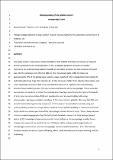Files in this item
Biogeography of the global ocean's mesopelagic zone
Item metadata
| dc.contributor.author | Proud, Roland | |
| dc.contributor.author | Cox, Martin James | |
| dc.contributor.author | Brierley, Andrew S. | |
| dc.date.accessioned | 2017-12-23T00:31:48Z | |
| dc.date.available | 2017-12-23T00:31:48Z | |
| dc.date.issued | 2017-01-09 | |
| dc.identifier | 247263482 | |
| dc.identifier | 5a79f44e-139d-4f0c-a067-9c2c806b7e5d | |
| dc.identifier | 85009094264 | |
| dc.identifier | 000391902500029 | |
| dc.identifier.citation | Proud , R , Cox , M J & Brierley , A S 2017 , ' Biogeography of the global ocean's mesopelagic zone ' , Current Biology , vol. 27 , no. 1 , pp. 113-119 . https://doi.org/10.1016/j.cub.2016.11.003 | en |
| dc.identifier.issn | 0960-9822 | |
| dc.identifier.other | ORCID: /0000-0002-8647-5562/work/35710929 | |
| dc.identifier.other | ORCID: /0000-0002-6438-6892/work/60427341 | |
| dc.identifier.uri | https://hdl.handle.net/10023/12382 | |
| dc.description | The work has arisen from a PhD studentship funded by Australian Antarctic Division, University of Tasmania, and School of Biology. This study has received support from the European H2020 International Cooperation project MESOPP (Mesopelagic Southern Ocean Prey and Predators; http://www.mesopp.eu/). | en |
| dc.description.abstract | The global ocean’s near-surface can be partitioned into distinct provinces on the basis of regional primary productivity and oceanography [1]. This ecological geography provides a valuable framework for understanding spatial variability in ecosystem function, but has relevance only part way into the epipelagic zone (the top 200 m). The mesopelagic (200-1,000 m) makes up c. 20% of the global ocean volume, plays important roles in biogeochemical cycling [2], and holds potentially huge fish resources [3–5]. It is however hidden from satellite observation, and a lack of globally-consistent data has prevented development of a global-scale understanding. Acoustic Deep Scattering Layers (DSLs) are prominent features of the mesopelagic. These vertically-narrow (10s-100s of m) but horizontally-extensive (continuous for 10s-1,000s of km) layers comprise fish and zooplankton, and are readily detectable using echosounders. We have compiled a database of DSL characteristics globally. We show here that DSL depth and acoustic backscattering intensity (a measure of biomass) can be modelled accurately using just surface primary productivity, temperature and wind-stress. Spatial variability in these environmental factors leads to a natural partition of the mesopelagic into 10 distinct classes. These classes demark a more complex biogeography than the latitudinally-banded schemes proposed before [6,7]. Knowledge of how environmental factors influence the mesopelagic enables future change to be explored: we predict that by 2100 there will be widespread homogenisation of mesopelagic communities, and that mesopelagic biomass could increase by c. 17%. The biomass increase requires increased trophic efficiency, which could arise because of ocean warming and DSL shallowing. | |
| dc.format.extent | 7 | |
| dc.format.extent | 577011 | |
| dc.language.iso | eng | |
| dc.relation.ispartof | Current Biology | en |
| dc.subject | Pelagic ecology | en |
| dc.subject | Ecological geography | en |
| dc.subject | Environmental change | en |
| dc.subject | Trophic efficiency | en |
| dc.subject | Ocean warming | en |
| dc.subject | Marine acoustics | en |
| dc.subject | Deep scattering layers | en |
| dc.subject | Longhurst | en |
| dc.subject | Myctophid | en |
| dc.subject | GC Oceanography | en |
| dc.subject | QH301 Biology | en |
| dc.subject | NDAS | en |
| dc.subject | BDC | en |
| dc.subject | R2C | en |
| dc.subject | SDG 14 - Life Below Water | en |
| dc.subject.lcc | GC | en |
| dc.subject.lcc | QH301 | en |
| dc.title | Biogeography of the global ocean's mesopelagic zone | en |
| dc.type | Journal article | en |
| dc.contributor.sponsor | European Commission | en |
| dc.contributor.institution | University of St Andrews. School of Biology | en |
| dc.contributor.institution | University of St Andrews. Scottish Oceans Institute | en |
| dc.contributor.institution | University of St Andrews. Marine Alliance for Science & Technology Scotland | en |
| dc.contributor.institution | University of St Andrews. Centre for Research into Ecological & Environmental Modelling | en |
| dc.contributor.institution | University of St Andrews. Pelagic Ecology Research Group | en |
| dc.identifier.doi | https://doi.org/10.1016/j.cub.2016.11.003 | |
| dc.description.status | Peer reviewed | en |
| dc.date.embargoedUntil | 2017-12-22 | |
| dc.identifier.grantnumber | 692173 | en |
This item appears in the following Collection(s)
Items in the St Andrews Research Repository are protected by copyright, with all rights reserved, unless otherwise indicated.

